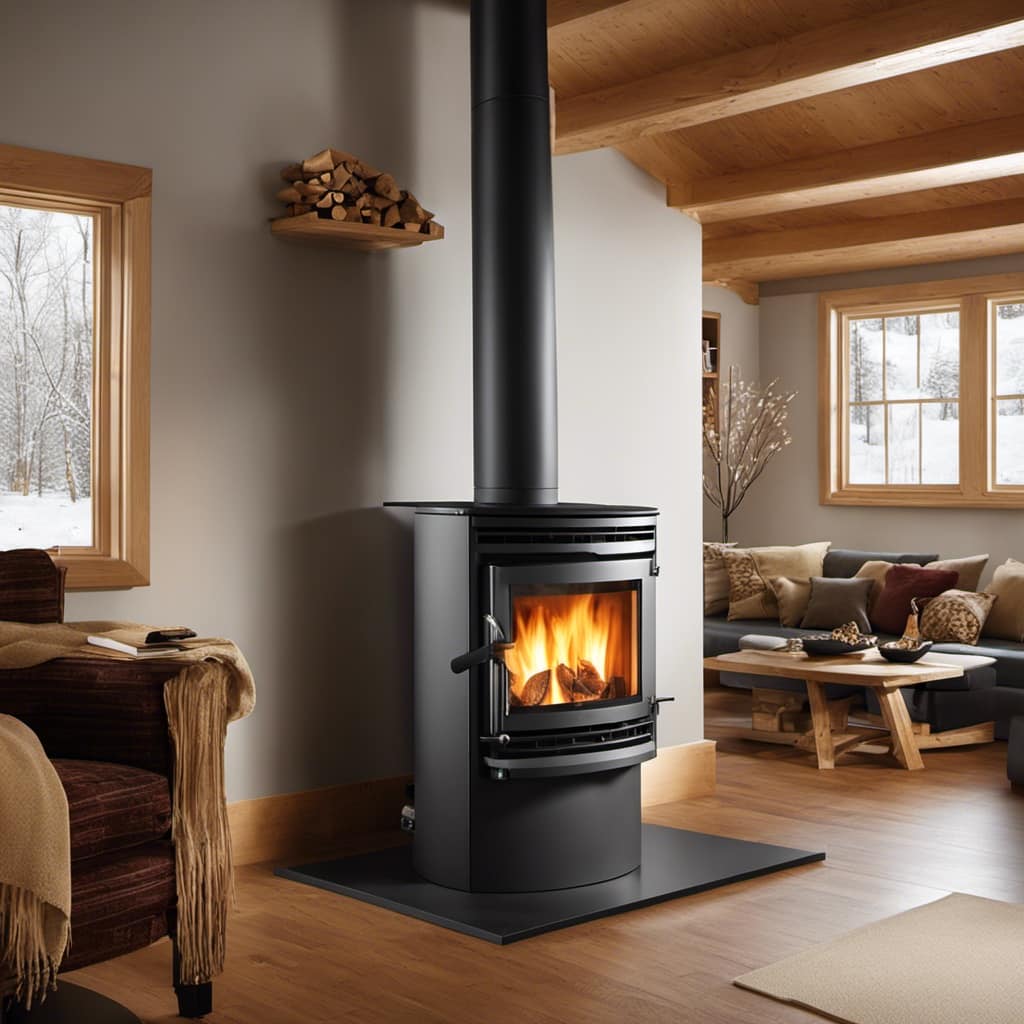
Alright everyone, let’s get into the details of how to set up a wood stove pipe. Believe me, it might seem challenging, but with the proper knowledge, it is actually quite straightforward.
In this article, I’ll guide you through each step, from selecting the appropriate materials to properly positioning and sealing the pipes.
We’ll even cover essential maintenance tips to keep your wood stove piping in top-notch condition.
So, grab your tools and let’s get started!
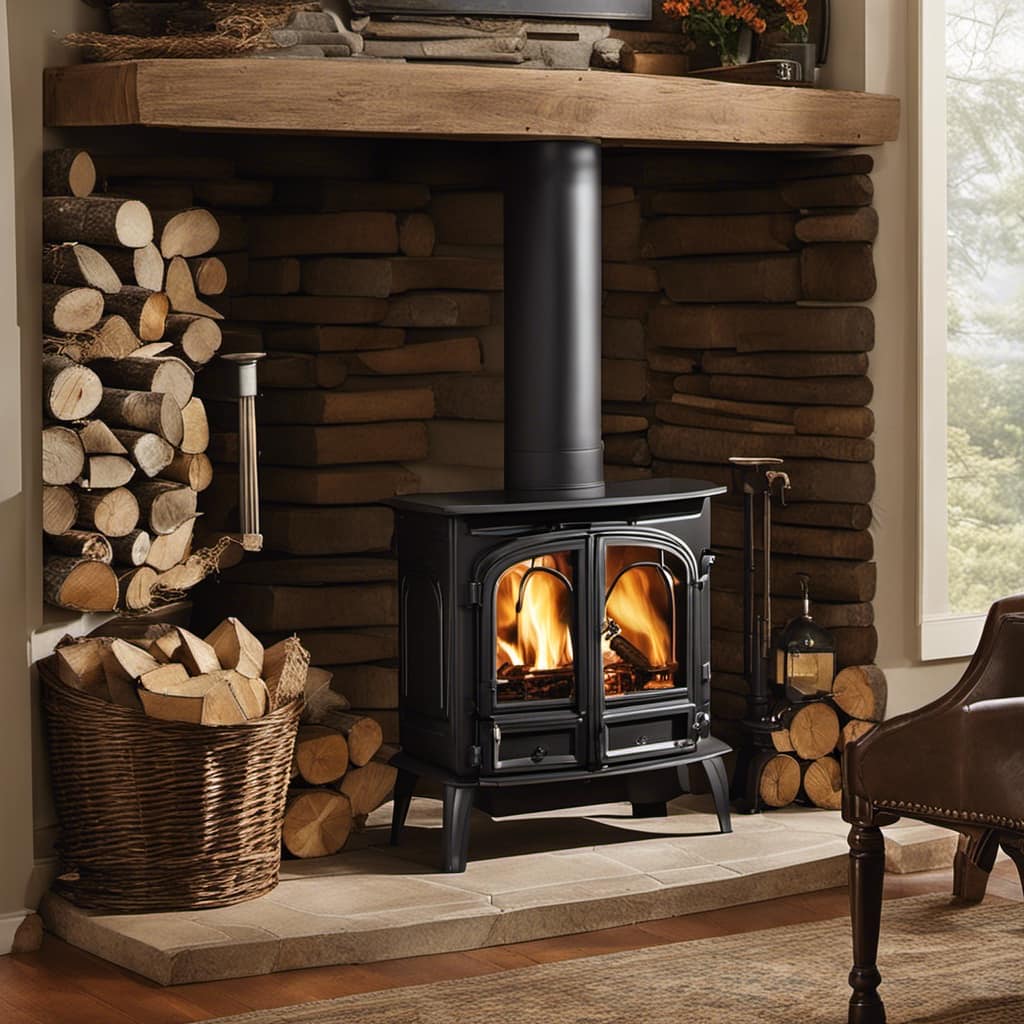
Key Takeaways
- Regular chimney cleaning is crucial for efficient and safe operation.
- Proper installation of pipe joints is essential to prevent leaks and gas escape.
- Stainless steel pipes offer durability and resistance to corrosion.
- Double wall pipes provide improved safety and increased efficiency.
Understanding the Basics of Wood Stove Piping
I need to learn the basics of wood stove piping to properly set up my new stove. One important aspect of wood stove piping is the regular cleaning of the chimney. This is crucial to ensure the efficient and safe operation of the wood stove. Over time, soot and creosote can build up in the chimney, which can lead to blockages and increased risk of chimney fires. Regular chimney cleaning, at least once a year, will help prevent these issues and maintain good airflow for proper combustion.
When installing wood stove piping, there are common mistakes that should be avoided. One such mistake is improper sizing of the pipe. It’s important to correctly match the pipe size to the stove’s outlet and the chimney opening. Using an undersized pipe can result in poor draft and inefficient burning, while an oversized pipe can lead to excessive heat loss.
Another mistake to avoid is improper installation of the pipe joints. It’s crucial to ensure that the joints are properly sealed to prevent leaks and the escape of harmful gases. Using a high-temperature sealant or stove pipe tape can help create a tight and secure seal.
Selecting the Right Pipe Materials for Your Wood Stove
One option for selecting the right pipe materials for your wood stove is to use stainless steel, as it offers durability and resistance to corrosion. Stainless steel pipes are known for their strength and ability to withstand high temperatures, making them ideal for wood stove applications. Additionally, stainless steel pipes have a smooth interior surface, which promotes better draft and reduces the buildup of creosote.

When choosing appropriate insulation for your wood stove pipe, it’s important to consider the type of insulation that will work best for your specific needs. There are various types of insulation available, including ceramic fiber insulation, mineral wool insulation, and foil-faced insulation. Each type has its advantages and disadvantages, so it’s essential to do thorough research and consult with professionals to determine the most suitable option for your wood stove pipe.
Advantages of double wall pipes include improved safety and increased efficiency. The double wall construction provides an extra layer of insulation, reducing the risk of heat transfer to surrounding materials and minimizing the chance of accidental fires. Additionally, the insulation helps to maintain higher flue gas temperatures, allowing for more efficient combustion and reducing the amount of creosote buildup.
Properly Positioning and Installing the Stove Pipe
Positioning and installing the stove pipe correctly is essential for ensuring proper ventilation and preventing any potential safety hazards. When installing the stove pipe, it’s important to follow these steps:
- Measure and cut the stove pipe to the required length using a pipe cutter or hacksaw.
- Attach the stove pipe to the flue collar of the wood stove, making sure it fits securely.
- Use high-temperature silicone sealant to create an airtight seal between the stove pipe and the flue collar.
- Secure the stove pipe in place using metal screws or clamps, ensuring it’s properly supported.
- Install a chimney cap or rain cap on top of the stove pipe to prevent water and debris from entering.
Troubleshooting common pipe issues may include checking for any gaps or leaks in the stove pipe, ensuring proper clearance between the pipe and combustible materials, and inspecting for any blockages or obstructions that may hinder proper ventilation.
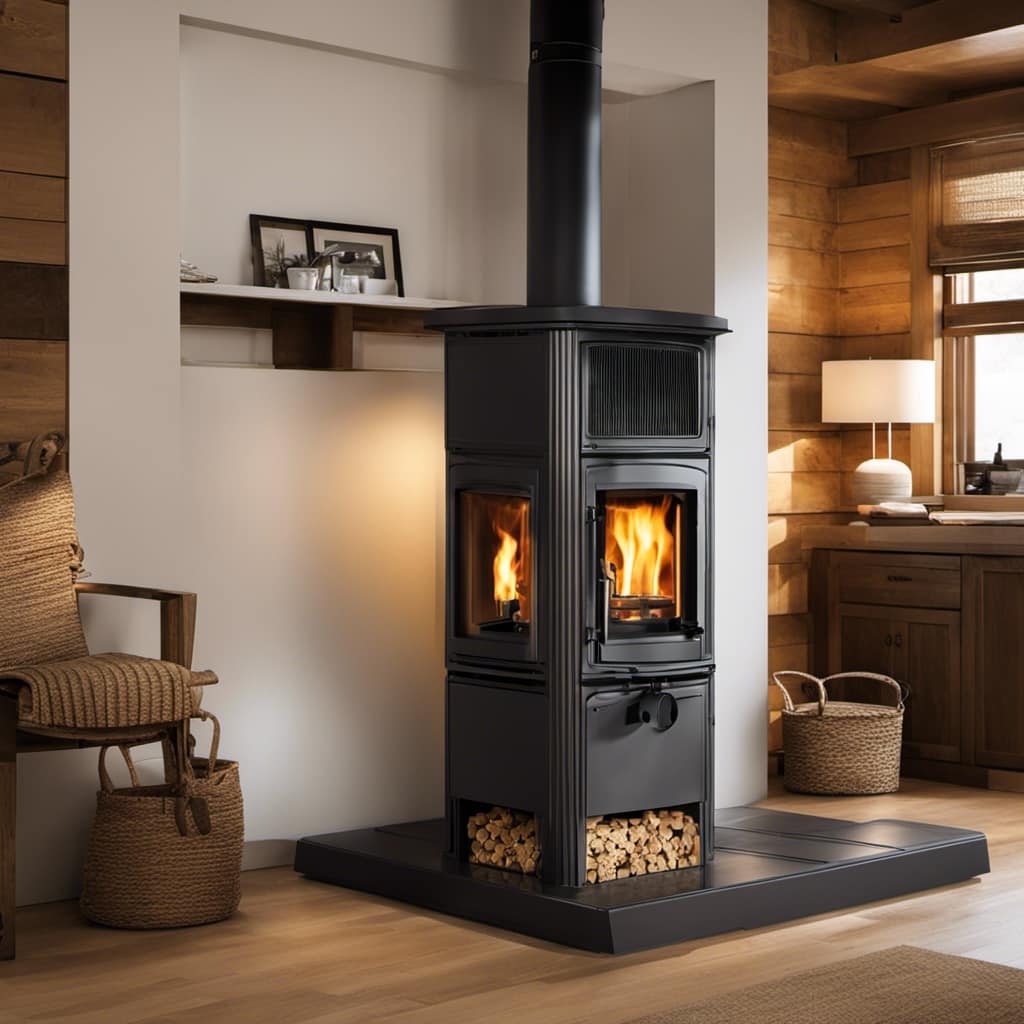
Regular maintenance and inspection of the stove pipe is crucial to ensure its efficient and safe operation.
Connecting and Sealing the Pipes for Effective Ventilation
To ensure effective ventilation, it is crucial to properly connect and seal the pipes using high-temperature silicone sealant. This step is essential when installing a chimney for a wood stove. Here is a step-by-step guide on how to connect and seal the pipes:
- First, gather all the necessary materials: high-temperature silicone sealant, pipe sections, clamps, and a screwdriver.
- Start by connecting the pipe sections together, ensuring they fit snugly.
- Apply a generous amount of high-temperature silicone sealant to the connecting ends of the pipes.
- Use clamps to secure the pipes together, ensuring a tight connection.
- Allow the silicone sealant to cure according to the manufacturer’s instructions.
- Once cured, inspect the connections for any leaks or gaps.
- If any leaks or gaps are found, apply additional silicone sealant to seal them completely.
- Finally, troubleshoot ventilation by running a smoke test to ensure proper airflow.
| Step | Instructions |
|---|---|
| 1 | Gather materials |
| 2 | Connect pipe sections |
| 3 | Apply sealant to connecting ends |
| 4 | Secure pipes with clamps |
| 5 | Allow sealant to cure |
| 6 | Inspect connections |
| 7 | Apply additional sealant if needed |
| 8 | Troubleshoot ventilation with a smoke test |
Essential Maintenance Tips for Wood Stove Piping
I find it important to regularly clean and inspect the wood stove piping to ensure proper functionality and prevent potential hazards. Inspecting chimneys and cleaning creosote buildup are crucial steps in maintaining a safe and efficient wood stove system. Here’s a step-by-step guide:
- Start by turning off the wood stove and allowing it to cool completely.
- Put on protective gloves and eyewear before beginning the inspection.
- Use a flashlight to visually inspect the chimney for any signs of damage or obstruction.
- Check for creosote buildup by shining the light up the chimney and looking for a shiny, black substance.
- If creosote is present, it needs to be cleaned to prevent chimney fires. Use a creosote sweeping brush or hire a professional chimney sweep.
- Lastly, inspect the piping connections for any leaks or loose fittings. Tighten any loose connections and replace damaged parts if necessary.
Regularly inspecting and cleaning your wood stove piping will ensure its proper functionality and minimize the risk of potential hazards.
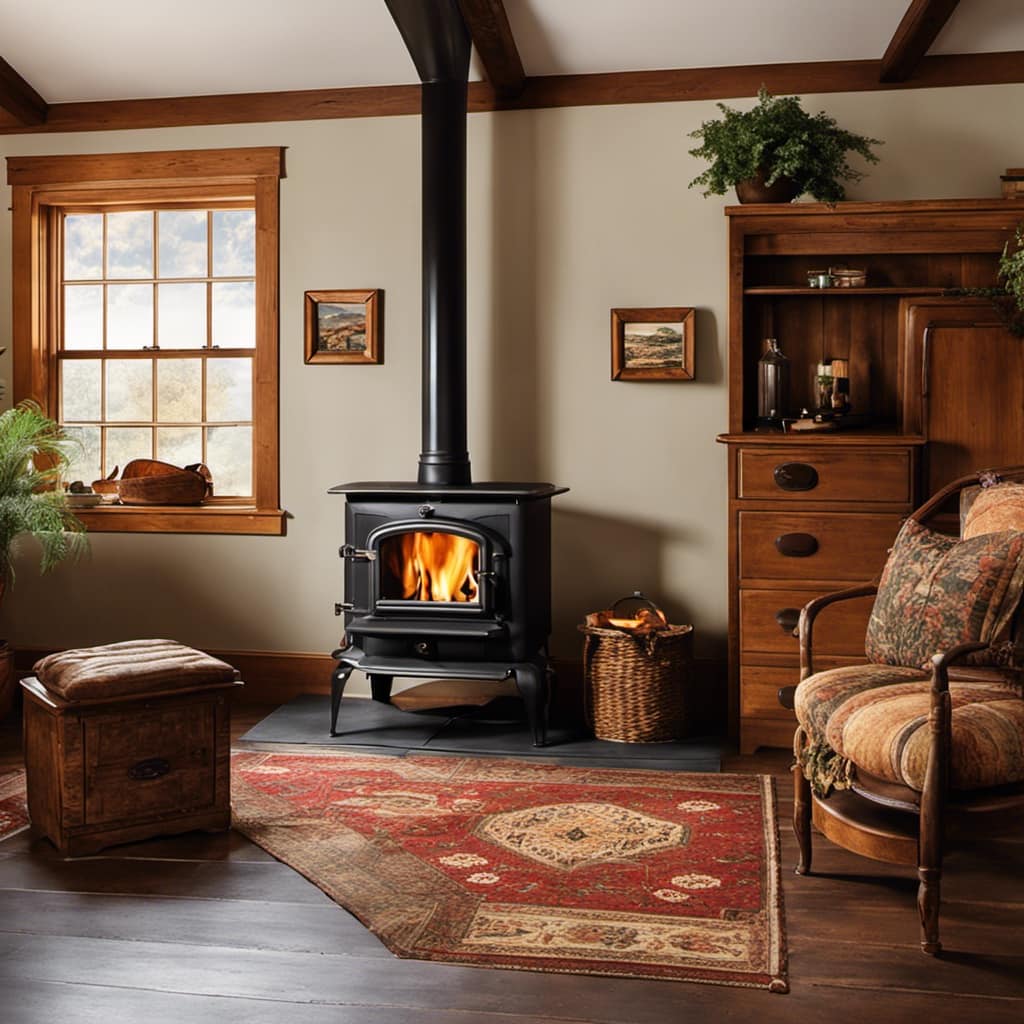
Frequently Asked Questions
How Much Clearance Is Required Between the Stove Pipe and Combustible Materials?
Proper clearance requirements for wood stove pipes are essential to prevent fires. It’s crucial to maintain a safe distance between the stove pipe and combustible materials. Common mistakes to avoid when installing wood stove pipes include insufficient clearance and improper insulation.
Can I Use a Different Type of Pipe Material for the Exterior Portion of the Stove Pipe?
Yes, you can use different types of pipe materials for the exterior portion of the stove pipe. However, it is important to consider the pros and cons of each material to ensure proper functionality and safety.
What Is the Best Way to Clean and Maintain the Stove Pipe?
To clean and maintain a wood stove pipe, start by removing any debris or creosote buildup with a chimney brush. Inspect for any damage or leaks, and replace any damaged sections. Regularly check and clean the pipe to ensure proper functioning.
Is It Possible to Install a Wood Stove Pipe Without Professional Help?
I’ve always been curious if it’s possible to install a wood stove pipe without professional help. I decided to investigate and found that with the right tools and knowledge, a DIY wood stove installation is definitely achievable.
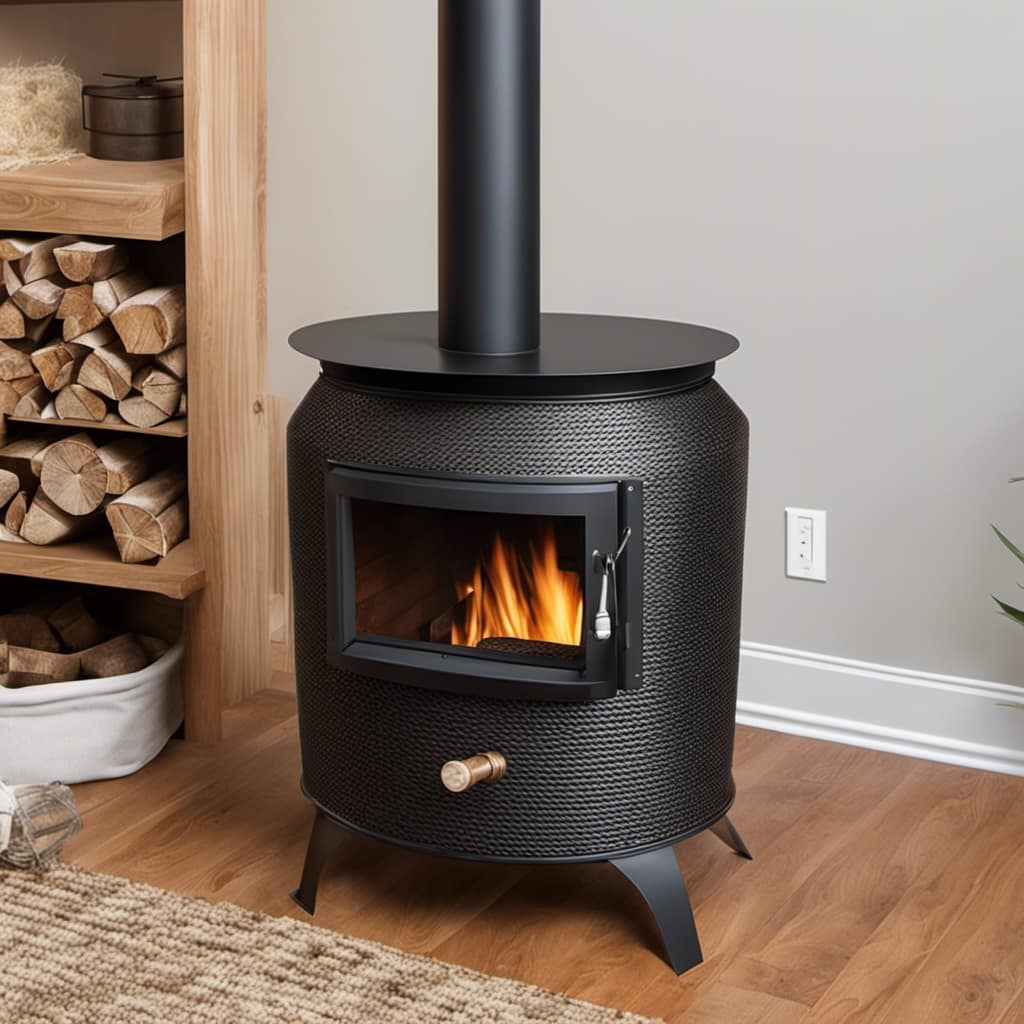
Are There Any Specific Regulations or Codes That I Need to Follow When Installing a Wood Stove Pipe?
When installing a wood stove pipe, it’s important to follow specific regulations and codes to ensure safety. This includes understanding the installation process, implementing safety measures, and avoiding common mistakes.
Conclusion
In conclusion, properly piping a wood stove is crucial for effective ventilation and safety. By understanding the basics, selecting the right materials, positioning and installing the stove pipe correctly, and connecting and sealing the pipes, you can ensure optimal performance.
Remember to also follow essential maintenance tips to keep your wood stove piping in top condition. So, get ready to experience the warmth and coziness of your wood stove, like being wrapped in a toasty embrace on a cold winter’s night.
Growing up surrounded by the vast beauty of nature, Sierra was always drawn to the call of the wild. While others sought the comfort of the familiar, she ventured out, embracing the unpredictable and finding stories in the heartbeat of nature.
At the epicenter of every remarkable venture lies a dynamic team—a fusion of diverse talents, visions, and passions. The essence of Best Small Wood Stoves is crafted and refined by such a trio: Sierra, Logan, and Terra. Their collective expertise has transformed the platform into a leading authority on small wood stoves, radiating warmth and knowledge in equal measure.










